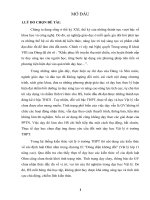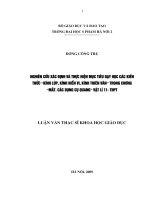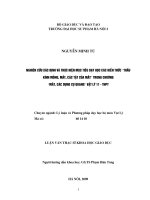Bài giảng Tài chính doanh nghiệp Chương 4: Vốn và tài trợ vốn dài hạn cho doanh nghiệp
Bạn đang xem bản rút gọn của tài liệu. Xem và tải ngay bản đầy đủ của tài liệu tại đây (317.6 KB, 39 trang )
Chương 4
Vốn
Vốn và
và tài
tài trợ
trợ vốn
vốn dài
dài hạn
hạn
cho
cho doanh
doanh nghiệp
nghiệp
Vốn và tài trợ vốn dài hạn
của doanh nghiệp
• Vốn, tài sản và dòng tiền trong doanh
•
•
•
nghiệp
Các loại vốn trong doanh nghiệp
Các công cụ tài trợ vốn dài hạn cho
doanh nghiệp
Chính sách tài trợ vốn dài hạn của doanh
nghiệp
Vốn, tài sản trong doanh
nghiệp
Tổng số tài sản = Tổng số vốn
– Vốn là biểu hiện bằng tiền của toàn bộ tài sản của
doanh nghiệp
– Tiền là vốn khi:
- Số lượng tiền phải đủ lớn
- Tiền luôn luôn vận động
- Được sử dụng vào hoạt động sản xuất, kinh doanh nhằm
mục đích sinh lời.
Dòng tiền trong doanh nghiệp
Dòng tiền vào
– Vốn tự có
– Vốn đi vay
– Lợi nhuận không
chia
– Doanh thu
– Các khoản nợ phải
thu…
Doanh
nghiệp
Dòng tiền ra
Tiền gửi NH
Cho vay
Chi phí
Đầu tư
chứng khoán
Các khoản
nợ phải
trả…
Dòng tiền
trong doanh nghiệp
Dòng tiền đối trọng
Hàng hoá, dịch vụ
Doanh
Hàng hoá, dịch vụ nghiệp
Tài sản tài chính
Tiền (thanh toán ngay)
Tiền (thanh toán sau)
Tiền (đầu tư tài chính )
Dòng tiền đối trọng trực tiếp
Dòng tiền đối trọng gián tiếp
Dòng tiền đối trọng đa/phi kỳ hạn
Dòng tiền
trong doanh nghiệp
Dòng tiền độc lập
Huy động vốn góp Doanh
Vay mượn tiền
………………..
nghiệp
Cho vay
Nộp thuế
Nộp tiền phạt
……………..
Các loại vốn trong doanh
nghiệp
•
•
•
Căn cứ vào hình thức sở hữu
Căn cứ vào đặc điểm luân chuyển
Căn cứ vào thời gian sử dụng
Phân loại theo tính chất sở
hữu (nguồn hình thành)
Vốn chủ sở hữu (Shareholder s Capital) Là tổng
số vốn góp của các chủ sở hữu vào doanh nghiệp
Tăng (giảm) vốn
Vốn
chủ
sở
hữu
+(-) Vốn góp bổ sung
+(-) Giá trị cổ phiếu
Vốn góp
+
+(-) Lợi nhuận giữ lại
ban đầu
+(-) Đánh giá lại tài sản
+(-) Kết quả kinh doanh
=
Phân loại theo tính chất sở
hữu (nguồn hình thành)
Nợ phải trả (Liabilities) -- Là tổng số vốn
doanh nghiệp không có quyền sở hữu nhưng
có quyền sử dụng.
Vay người thân
Vay các tổ chức tín dụng
Nợ phải
Tín dụng thương mại (vốn chiếm dụng)
trả
=
Các khoản tạm ứng từ khách hàng
Các khoản nợ phải trả khác…
Phân loại theo hình thức sở
hữu
Hệ số đảm bảo
nợ
=
Nợ phải trả
Vốn chủ sở hữu
Hệ số đảm bảo nợ = 1
Hệ số đảm bảo nợ < 1
Hệ số đảm bảo nợ > 1
Phân loại theo đặc điểm
chuyển vốn
Vốn cố định -- Là tổng số vốn ứng trước
hình thành nên tài sản cố định của doanh
nghiệp
Đặc điểm
- Thời gian luân chuyển dài
- Giá trị vốn cố định dịch chuyển dần và
từng phần vào chi phí kinh doanh
Phân loại theo đặc điểm
chuyển vốn
Vốn lưu động -- Là tổng số vốn ứng trước
hình thành nên tài sản lưu động của doanh
nghiệp
Đặc điểm
- Thời gian luân chuyển ngắn
- Giá trị vốn cố định dịch chuyển một lần và
toàn bộ vào chi phí kinh doanh
Phân loại theo thời gian sử
dụng
Vốn thường xuyên -- Là số vốn doanh
nghiệp có thể sử dụng lâu dài vào hoạt động
sản xuất kinh doanh (> 1 năm)
Vốn
thường
xuyên
=
Vốn chủ
sở hữu
+
Nợ dài
hạn
Phân loại theo thời gian sử
dụng
Vốn tạm thời -- Là số vốn doanh nghiệp có
thể sử dụng trong thời gian ngắn vào hoạt
động sản xuất kinh doanh
-
Vay ngắn hạn
-
Các khoản phải trả nhà cung cấp
-
Các khoản vốn chiếm dụng
-
Nợ dài hạn đến hạn hạn trả …
Các hình thức tài trợ vốn
dài hạn cho doanh nghiệp
•Tín dụng ngân hàng
•Tài trợ vốn thông qua thị trường chứng khoán
- Cổ phiếu
- Trái phiếu
–Tài trợ vốn thông hoạt động thuê tài chính
– Tài trợ vốn bằng lợi nhuận giữ lại
“Stand-Alone”
Commercial Paper
Commercial Paper -- Short-term, unsecured
promissory notes, generally issued by large
corporations (unsecured corporate IOUs).
– Commercial paper market is composed of the (1)
dealer and (2) direct-placement markets.
– Advantage: Cheaper than a short-term business
loan from a commercial bank.
– Dealers require a line of credit to ensure that the
commercial paper is paid off.
“Bank-Supported”
Commercial Paper
A bank provides a letter of credit,
credit for a fee,
guaranteeing the investor that the company’s
obligation will be paid.
– Letter of credit (L/C) -- A promise from a third
party (usually a bank) for payment in the event
that certain conditions are met. It is frequently
used to guarantee payment of an obligation.
– Best for lesser-known firms to access lower cost
funds.
Bankers’ Acceptances
Bankers’ Acceptances -- Short-term
promissory trade notes for which a bank (by
having “accepted” them) promises to pay
the holder the face amount at maturity.
– Used to facilitate foreign trade or the shipment of certain marketable
goods.
– Liquid market provides rates similar to commercial paper rates.
Short-Term
Business Loans
Unsecured Loans -- A form of debt for
money borrowed that is not backed by
the pledge of specific assets.
• Secured Loans -- A form of debt for money borrowed
in which specific assets have been pledged to
guarantee payment.
Unsecured Loans
Line of Credit (with a bank) -- An informal
arrangement between a bank and its
customer specifying the maximum amount of
unsecured credit the bank will permit the firm
to owe at any one time.
• One-year limit that is reviewed prior to renewal to
determine if conditions necessitate a change.
• Credit line is based on the bank’s assessment of the
creditworthiness and credit needs of the firm.
• “Cleanup” provision requires the firm to owe the
bank nothing for a period of time.
Unsecured Loans
Revolving Credit Agreement -- A formal, legal
commitment to extend credit up to some
maximum amount over a stated period of time.
• Firm receives revolving credit by paying a
commitment fee on any unused portion of the
maximum amount of credit.
– Commitment fee -- A fee charged by the lender for agreeing
to hold credit available.
• Agreements frequently extend beyond 1 year.
Unsecured Loans
Transaction Loan -- A loan agreement
that meets the short-term funds needs of
the firm for a single, specific purpose.
• Each request is handled as a separate transaction by
•
the bank, and project loan determination is based
on the cash-flow ability of the borrower.
The loan is paid off at the completion of the project
by the firm from resulting cash flows.
Detour: Cost of Borrowing
Interest Rates
Prime Rate -- Short-term interest rate charged
by banks to large, creditworthy customers.
Differential from prime depends on:
– Cash balances
– Other business with the bank
– Cost of servicing the loan
Detour: Cost of Borrowing
Computing Interest Rates
Collect Basis -- interest is paid at maturity of
the note.
Example: $100,000 loan at 10%
stated interest rate for 1 year.
$10,000 in interest
$100,000 in usable funds
= 10.00%
Detour: Cost of Borrowing
Computing Interest Rates
Discount Basis -- interest is deducted from
the initial loan.
Example: $100,000 loan at 10%
stated interest rate for 1 year.
$10,000 in interest
$90,000 in usable funds
= 11.11%









